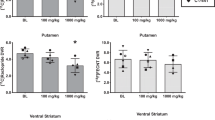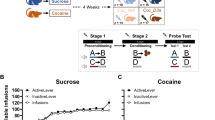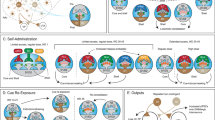Abstract
The goal of this study was to determine D1 receptor availability in human cocaine-dependent (CD) subjects and matched healthy controls (HCs). In addition, the CD subjects performed cocaine self-administration sessions in order to explore the association between D1 receptor availability and cocaine-seeking behavior. Twenty-five CD subjects (40±4 years, 19M/6 F) and 23 matched HCs (38±4 years, 19M/4F) were scanned with PET and the radiotracer [11C]NNC 112. During the cocaine self-administration sessions, CD volunteers were given the choice to self-administer cocaine (0, 6, and 12 mg) or to receive a monetary voucher worth $5. D1 receptor availability was measured in the limbic, associative, and sensori-motor striatum in addition to cortical brain regions. No difference in D1 receptor availability was seen between the two groups. A negative association was seen between D1 receptor BPND in the limbic striatum and the choice for the 6 mg dose of cocaine (r=−0.47, p=0.02, corrected for age). These results do not support the hypothesis that cocaine dependence is associated with a reduction in D1 receptor availability in the striatum. However, within the CD subjects, low D1 receptor availability in the ventral striatum was associated with the choice to self-administer cocaine, suggesting that low D1 receptor availability may be associated with an increased risk of relapse in cocaine dependence.
Similar content being viewed by others
Log in or create a free account to read this content
Gain free access to this article, as well as selected content from this journal and more on nature.com
or
References
Abi-Dargham A, Martinez D, Mawlawi O, Simpson N, Hwang DR, Slifstein M et al (2000). Measurement of striatal and extrastriatal dopamine D1 receptor binding potential with [11C]NNC 112 in humans: validation and reproducibility. J Cereb Blood Flow Metab 20: 225–243.
Alleweireldt AT, Weber SM, Kirschner KF, Bullock BL, Neisewander JL (2002). Blockade or stimulation of D1 dopamine receptors attenuates cue reinstatement of extinguished cocaine-seeking behavior in rats. Psychopharmacology (Berl) 159: 284–293.
Bachtell RK, Whisler K, Karanian D, Self DW (2005). Effects of intra-nucleus accumbens shell administration of dopamine agonists and antagonists on cocaine-taking and cocaine-seeking behaviors in the rat. Psychopharmacology (Berl) 183: 41–53.
Baker DA, Fuchs RA, Specio SE, Khroyan TV, Neisewander JL (1998). Effects of intraaccumbens administration of SCH-23390 on cocaine-induced locomotion and conditioned place preference. Synapse 30: 181–193.
Barrett AC, Miller JR, Dohrmann JM, Caine SB (2004). Effects of dopamine indirect agonists and selective D1-like and D2-like agonists and antagonists on cocaine self-administration and food maintained responding in rats. Neuropharmacology 47 (Suppl 1): 256–273.
Ben-Shahar O, Keeley P, Cook M, Brake W, Joyce M, Nyffeler M et al (2007). Changes in levels of D1, D2, or NMDA receptors during withdrawal from brief or extended daily access to IV cocaine. Brain Res 1131: 220–228.
Beveridge TJ, Smith HR, Nader MA, Porrino LJ (2008). Abstinence from chronic cocaine self-administration alters striatal dopamine systems in rhesus monkeys. Neuropsychopharmacology. [e-pub ahead of print].
Caine SB, Heinrichs SC, Coffin VL, Koob GF (1995). Effects of the dopamine D-1 antagonist SCH 23390 microinjected into the accumbens, amygdala or striatum on cocaine self-administration in the rat. Brain Res 692: 47–56.
Caine SB, Negus SS, Mello NK, Bergman J (1999). Effects of dopamine D(1-like) and D(2-like) agonists in rats that self-administer cocaine. J Pharmacol Exp Ther 291: 353–360.
Caine SB, Thomsen M, Gabriel KI, Berkowitz JS, Gold LH, Koob GF et al (2007). Lack of self-administration of cocaine in dopamine D1 receptor knock-out mice. J Neurosci 27: 13140–13150.
Dagher A, Bleicher C, Aston JA, Gunn RN, Clarke PB, Cumming P (2001). Reduced dopamine D1 receptor binding in the ventral striatum of cigarette smokers. Synapse 42: 48–53.
De Vries TJ, Schoffelmeer AN, Binnekade R, Vanderschuren LJ (1999). Dopaminergic mechanisms mediating the incentive to seek cocaine and heroin following long-term withdrawal of IV drug self-administration. Psychopharmacology (Berl) 143: 254–260.
Dias C, Lachize S, Boilet V, Huitelec E, Cador M (2004). Differential effects of dopaminergic agents on locomotor sensitisation and on the reinstatement of cocaine-seeking and food-seeking behaviour. Psychopharmacology (Berl) 175: 414–427.
Edwards S, Whisler KN, Fuller DC, Orsulak PJ, Self DW (2007). Addiction-related alterations in D1 and D2 dopamine receptor behavioral responses following chronic cocaine self-administration. Neuropsychopharmacology 32: 354–366.
Evans SM, Haney M, Foltin RW (2002). The effects of smoked cocaine during the follicular and luteal phases of the menstrual cycle in women. Psychopharmacology (Berl) 159: 397–406.
Farfel GM, Kleven MS, Woolverton WL, Seiden LS, Perry BD (1992). Effects of repeated injections of cocaine on catecholamine receptor binding sites, dopamine transporter binding sites and behavior in rhesus monkey. Brain Res 578: 235–243.
Foltin RW, Fischman MW, Nestadt G, Stromberger H, Cornell EE, Pearlson GD (1990). Demonstration of naturalistic methods for cocaine smoking by human volunteers. Drug Alcohol Depend 26: 145–154.
Foltin RW, Ward AS, Collins ED, Haney M, Hart CL, Fischman MW (2003). The effects of venlafaxine on the subjective, reinforcing, and cardiovascular effects of cocaine in opioid-dependent and non-opioid-dependent humans. Exp Clin Psychopharmacol 11: 123–130.
Haber SN, Fudge JL (1997). The primate substantia nigra and VTA: Integrative circuitry and function. Crit Rev Neurobiol 11: 323–342.
Halldin C, Foged C, Chou YH, Karlsson P, Swahn CG, Sandell J et al (1998). Carbon-11-NNC 112: a radioligand for PET examination of striatal and neocortical D1-dopamine receptors. J Nucl Med 39: 2061–2068.
Haney M, Collins ED, Ward AS, Foltin RW, Fischman MW (1999). Effect of a selective dopamine D1 agonist (ABT-431) on smoked cocaine self-administration in humans. Psychopharmacology (Berl) 143: 102–110.
Haney M, Ward AS, Foltin RW, Fischman MW (2001). Effects of ecopipam, a selective dopamine D1 antagonist, on smoked cocaine self-administration by humans. Psychopharmacology (Berl) 155: 330–337.
Innis RB, Cunningham VJ, Delforge J, Fujita M, Gjedde A, Gunn RN et al (2007). Consensus nomenclature for in vivo imaging of reversibly binding radioligands. J Cereb Blood Flow Metab 27: 1533–1539.
Joel D, Weiner I (2000). The connections of the dopaminergic system with the striatum in rats and primates: an analysis with respect to the functional and compartmental organization of the striatum. Neuroscience 96: 451–474.
Katz JL, Witkin JM (1992). Selective effects of the D1 dopamine receptor agonist, SKF 38393, on behavior maintained by cocaine injection in squirrel monkeys. Psychopharmacology 109: 241–244.
Khroyan TV, Barrett-Larimore RL, Rowlett JK, Spealman RD (2000). Dopamine D1- and D2-like receptor mechanisms in relapse to cocaine-seeking behavior: effects of selective antagonists and agonists. J Pharmacol Exp Ther 294: 680–687.
Khroyan TV, Platt DM, Rowlett JK, Spealman RD (2003). Attenuation of relapse to cocaine seeking by dopamine D1 receptor agonists and antagonists in non-human primates. Psychopharmacology (Berl) 168: 124–131.
Kleven MS, Perry BD, Woolverton WL, Seiden LS (1990). Effects of repeated injections of cocaine on D1 and D2 dopamine receptors in rat brain. Brain Res 532: 265–270.
Kleven MS, Woolverton WL (1990). Effects of continuous infusions of SCH 23390 on cocaine- or food-maintained behavior in rhesus monkeys. Behav Pharmacol 1: 365–373.
Lim DK, Yu ZJ, Hoskins B, Rockhold RW, Ho IK (1990). Effects of acute and subacute cocaine administration on the CNS dopaminergic system in Wistar-Kyoto and spontaneously hypertensive rats: II Dopamine receptors. Neurochem Res 15: 621–627.
Maldonado R, Robledo P, Chover AJ, Caine SB, Koob GF (1993). D1 dopamine receptors in the nucleus accumbens modulate cocaine self-administration in the rat. Pharmacol Biochem Behav 45: 239–242.
Martinez D, Broft A, Foltin RW, Slifstein M, Hwang DR, Huang Y et al (2004). Cocaine dependence and d2 receptor availability in the functional subdivisions of the striatum: relationship with cocaine-seeking behavior. Neuropsychopharmacology 29: 1190–1202.
Martinez D, Slifstein M, Broft A, Mawlawi O, Hwang DR, Huang Y et al (2003). Imaging human mesolimbic dopamine transmission with positron emission tomography. Part II: amphetamine-induced dopamine release in the functional subdivisions of the striatum. J Cereb Blood Flow Metab 23: 285–300.
Meador-Woodruff JH, Little KY, Damask SP, Mansour A, Watson SJ (1993). Effects of cocaine on dopamine receptor gene expression: a study in the postmortem human brain. Biol Psychiatry 34: 348–355.
Milivojevic N, Krisch I, Sket D, Zivin M (2004). The dopamine D1 receptor agonist and D2 receptor antagonist LEK-8829 attenuates reinstatement of cocaine-seeking in rats. Naunyn Schmiedebergs Arch Pharmacol 369: 576–582.
Mintun MA, Raichle ME, Kilbourn MR, Wooten GF, Welch MJ (1984). A quantitative model for the in vivo assessment of drug binding sites with positron emission tomography. Ann Neurol 15: 217–227.
Moore RJ, Vinsant SL, Nader MA, Porrino LJ, Friedman DP (1998). Effect of cocaine self-administration on striatal dopamine D1 receptors in rhesus monkeys. Synapse 28: 1–9.
Mutschler NH, Bergman J (2002). Effects of chronic administration of the D1 receptor partial agonist SKF 77434 on cocaine self-administration in rhesus monkeys. Psychopharmacology (Berl) 160: 362–370.
Nader MA, Daunais JB, Moore T, Nader SH, Moore RJ, Smith HR et al (2002). Effects of Cocaine Self-administration on Striatal Dopamine Systems in Rhesus Monkeys. Initial and Chronic Exposure. Neuropsychopharmacology 27: 35–46.
Nazarian A, Russo SJ, Festa ED, Kraish M, Quinones-Jenab V (2004). The role of D1 and D2 receptors in the cocaine conditioned place preference of male and female rats. Brain Res Bull 63: 295–299.
Platt DM, Rowlett JK, Spealman RD (2001). Modulation of cocaine and food self-administration by low- and high-efficacy D1 agonists in squirrel monkeys. Psychopharmacology (Berl) 157: 208–216.
Schmidt HD, Pierce RC (2006). Cooperative activation of D1-like and D2-like dopamine receptors in the nucleus accumbens shell is required for the reinstatement of cocaine-seeking behavior in the rat. Neuroscience 142: 451–461.
Self D (2004). Drug dependence and addiction: neural substrates. Am J Psychiatry 161: 223.
Self DW, Barnhart WJ, Lehman DA, Nestler EJ (1996a). Opposite modulation of cocaine-seeking behavior by D1- and D2-like dopamine receptor agonists. Science 271: 1586–1589.
Self DW, Belluzzi JD, Kossuth S, Stein L (1996b). Self-administration of the D1 agonist SKF 82958 is mediated by D1, not D2, receptors. Psychopharmacology (Berl) 123: 303–306.
Self DW, Karanian DA, Spencer JJ (2000). Effects of the novel D1 dopamine receptor agonist ABT-431 on cocaine self-administration and reinstatement. Ann N Y Acad Sci 909: 133–144.
Shaham Y, Shalev U, Lu L, De Wit H, Stewart J (2003). The reinstatement model of drug relapse: history, methodology and major findings. Psychopharmacology (Berl) 168: 3–20.
Slifstein M, Kegeles LS, Gonzales R, Frankle WG, Xu X, Laruelle M et al (2007). [11C]NNC 112 selectivity for dopamine D1 and serotonin 5-HT(2A) receptors: a PET study in healthy human subjects. J Cereb Blood Flow Metab 27: 1733–1741.
Slifstein M, Laruelle M (2001). Models and methods for derivation of in vivo neuroreceptor parameters with PET and SPECT reversible radiotracers. Nucl Med Biol 28: 595–608.
Tsukada H, Kreuter J, Maggos CE, Unterwald EM, Kakiuchi T, Nishiyama S et al (1996). Effects of binge pattern cocaine administration on dopamine D1 and D2 receptors in the rat brain: an in vivo study using positron emission tomography. J Neurosci 16: 7670–7677.
Unterwald EM, Ho A, Rubenfeld JM, Kreek MJ (1994). Time course of the development of behavioral sensitization and dopamine receptor up-regulation during binge cocaine administration. J Pharmacol Exp Ther 270: 1387–1396.
Ventura AL, Sibley DR (2000). Altered regulation of the D(1) dopamine receptor in mutant Chinese hamster ovary cells deficient in cyclic AMP-dependent protein kinase activity. J Pharmacol Exp Ther 293: 426–434.
Woods RP, Cherry SR, Mazziotta JC (1992). Rapid automated algorithm for aligning and reslicing PET images. J Comput Assist Tomogr 16: 620–633.
Woods RP, Mazziotta JC, Cherry SR (1993). MRI-PET registration with automated algorithm. J Comput Assist Tomogr 17: 536–546.
Acknowledgements
The authors would like to thank Mabel Torres, Erica Scher, Ingrid Gelbard-Stokes, Elizabeth Hackett, and Hemant Belani for their excellent technical assistance. This study was supported by the Public Health Service NIDA PA50 DA 09236, NIDA K23 DA00483, and NIH M01RR00645.
Author information
Authors and Affiliations
Corresponding author
Additional information
DISCLOSURE/CONFLICT OF INTEREST
The authors report no conflicts of interest associated with the content of this paper.
Diana Martinez: no disclosures.
Mark Slifstein: received compensation for professional services from Glaxo-Smith-Kline, Amgen, and Yale University.
Rajesh Narendran: no disclosures.
Richard W Foltin: no disclosures.
Allegra Broft : no disclosures.
Dah-Ren Hwang: currently an employee of Amgen.
Audrey Perez: no disclosures.
Anissa Abi-Dargham: received compensation for professional services from Bristol Meyers Squibb-Otsuka, Sanofi-Aventis, Vanda Pharmaceuticals, Eli Lilly and Company.
Herbert D Kleber: no disclosures.
Marc Laruelle: currently an employee of Glaxo-Smith-Kline.
Rights and permissions
About this article
Cite this article
Martinez, D., Slifstein, M., Narendran, R. et al. Dopamine D1 Receptors in Cocaine Dependence Measured with PET and the Choice to Self-Administer Cocaine. Neuropsychopharmacol 34, 1774–1782 (2009). https://doi.org/10.1038/npp.2008.235
Received:
Revised:
Accepted:
Published:
Issue date:
DOI: https://doi.org/10.1038/npp.2008.235
Keywords
This article is cited by
-
Dopamine dysfunction in stimulant use disorders: mechanistic comparisons and implications for treatment
Molecular Psychiatry (2022)
-
Shifts in the neurobiological mechanisms motivating cocaine use with the development of an addiction-like phenotype in male rats
Psychopharmacology (2021)
-
Kappa-opioid receptors, dynorphin, and cocaine addiction: a positron emission tomography study
Neuropsychopharmacology (2019)
-
Striatal dopamine D1-type receptor availability: no difference from control but association with cortical thickness in methamphetamine users
Molecular Psychiatry (2018)
-
Low Striatal Dopamine D2-type Receptor Availability is Linked to Simulated Drug Choice in Methamphetamine Users
Neuropsychopharmacology (2018)



